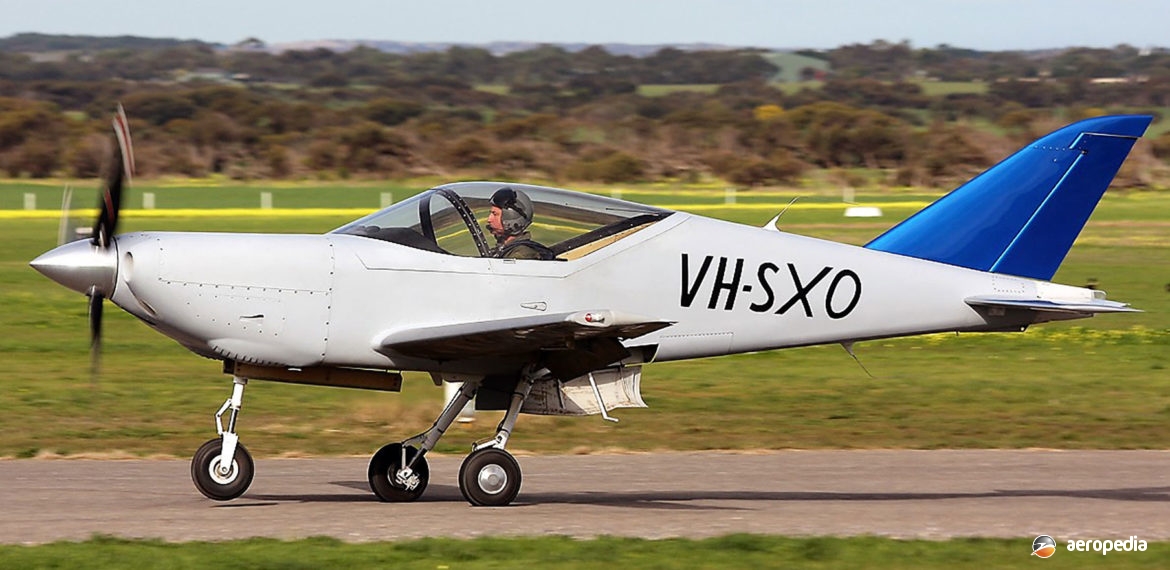Photograph:
Swearingen SX-300 VH-SXO (c/n SX-AUS-01) at Goolwa, SA in September 2010 (Andre Bezmylov)
Country of origin:
United States of America
Description:
Two-seat high performance sport monoplane
Power Plant:
One 224 kw (300 hp) Lycoming IO-540 six-cylinder horizontally-opposed air-cooled engine
Specifications:
- Wingspan: 7.46 m (24 ft 5 in)
- Length: 6.46 m (21 ft 2 in)
- Height: 2.4 m (7 ft 9 in)
- Max speed: 458 km/h (284 mph)
- Max cruising speed: 443 km/h (275 mph)
- Stalling speed clean: 139 km/h (86 mph)
- Stalling speed with flaps: 130 km/h (81 mph)
- Rate of climb at sea level: 732 m/min (2,400 ft/min)
- Range: 1,608 km (999 miles)
- Empty weight: 726 kg (1,600 lb)
- Loaded weight: 1,089 kg (2,400 lb)
History:
Designed by Edward J Swearingen of San Antonio, Texas, the SX-300, when it was released, was described as the ultimate kit-built aircraft, being the fastest, the most expensive and the most complex to build. It was initially supplied by Swearingen in a series of six construction kits. Power plant was the Lycoming IO-540 driving a 1.88 m (74 in) three-blade Hartzell propeller.
Swearingen over the years became known for designing high-performance aircraft, his designs including the Merlin and Metro turboprops. He was also involved in the development of the Piper Twin Comanche and the Piper Cheyenne. Cruising at 3,810 m (12,500 ft), the SX-300 on 65 per cent power had a cruising speed of 428 km/h (266 mph) and this provided a range of 1,815 km (1,128) miles with 45 minutes reserve. Manoeuvring speed was 289 km/h (180 mph) which allowed the pilot to maintain a relatively high speed in turbulence. Wing and fuselage skins were heavy gauge aluminium alloy, the skin of the aircraft providing much of the airframe strength. Flush riveting was used throughout the airframe, navigation and communication antennas being located in the fibreglass wingtips and in the tail. The aircraft had an electrically actuated hydraulic system and the undercarriage was fully enclosed when retracted.
Production of kits commenced in 1984, some 88 kits being known to be supplied to builders by late 1986 but production stopped in 1989. Only 48 sets of undercarriages were completed by the sub-contractor Airight of Wichita, Kansas. Only a few aircraft are known to have been completed in the United States, including N70SX, N53SX, N3RT, N330SX, N2H, N42SX, N54J, N74SX, N3RT, N41TS, N350G and N6Y.
In 2010 an example was imported by Mr Lyndon Trethaway of Goolwa SA, this being registered as VH-SXO³ (c/n SX-AUS-01) on 29 April 2010 and being fitted with a Textron Lycoming TIO-540-AE2A engine driving a Hartzell propeller.
Another example has been seen in Australia and New Zealand. This aircraft (N54JX – c/n 02) was used by the owner on a round-the world flight in 2014. On 1 July that year it arrived at Port Hedland in Western Australia and flew south to Jandakot in Perth. It then proceeded to Kalgoorlie, WA, Ayres Rock, NT, Hamilton Island, QLD, Cairns, QLD, Broken Hill, NSW on 4 August, then Parafield in Adelaide, SA, Coffs Harbour, NSW, and Lord Howe Island, arriving at Ardmore in New Zealand on 19 August. It was then stored for a few months at Wanaka while the owner, Heinz Peier, returned to Switzerland. The aircraft later left and returned to its home port.

